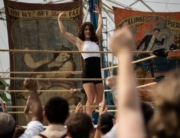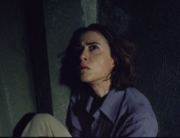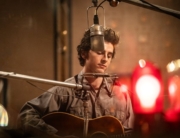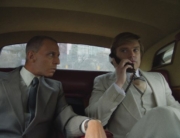
As if to clarify or thwart viewers’ expectations, the opening credits of Pablo Larraín’s miniature portrait of Princess Diana announces at the onset that it’s, “a fable from a true tragedy,” and for the rest of its running time it takes its cue from that declaration.
The atmosphere is funereal from the start. A procession of cars moves across a flat wintery landscape. A dead pheasant lies on the road, about to be squished again by an oncoming vehicle. The film is a mood piece, aided by the dissonant strings of Jonny Greenwood’s sprite and ever-present jazz and classical infused score, which does some heavy lifting during the film’s many long, arid stretches.
Steven Knight’s screenplay imagines the princess at her breaking point while spending the Christmas holidays with the entire royal family, circa 1991, at the suffocatingly formal and protocol-heavy Sandringham House. His script does not offer the vicarious thrill of checking off a mental scorecard based on real-life events like the TV series The Crown. However, the film assumes viewers already know the history of her marriage to Prince Charles.
This is Diana at her most depressed and needy, and as a loose cannon, constantly under surveillance, particularly by Major Alistair Gregory, played by Timothy Spall. With his pinched face and sour disposition, the equerry is a caricature out of a Dickens novel and the only member of the poker-face ensemble that sticks out.
The holiday is off to a fraught start on Christmas Eve: Diana becomes lost on the way to the countryside and arrives at the estate after the Queen, one of the no-no’s the onscreen princess commits, many of which are intentional. She has one friendly voice in her corner, her dresser Maggie (Sally Hawkins), a font of courage and the stand-in for die-hard Diana supporters: “Go on and fight them [the Windsors]. You are your own weapon.”
This advice perhaps foreshadows the publication of Andrew Morton’s 1992 bombshell bio, Diana: Her True Story, written with Diana’s cooperation. Even for those who have no idea of the revelations in the tell-all, moments in the movie will catch viewers partially up to speed, with the appearance of Camilla Parker Bowles at church and especially Diana’s bout with bulimia, which is more bluntly depicted here than in The Crown.
The palatial setting of Sandringham House adds to the gloom: darkly lit, with high ceilings that make anyone look diminutive, and portraits of royals of the past looking down at the present. In the kitchen, a sign hangs over the staff that admonishes anyone to speak loudly; “They can hear you.” Apart from Princess Diana and the courtiers, hardly anyone talks. It’s less like a monastery and more a mausoleum.
With shots of Diana wandering in the mists at night alone, the film adds a gothic touch. It becomes a ghost story with the scene-stealing appearance of Anne Boleyn as a harbinger. She begins haunting Diana after someone has placed a biography of Henry VIII’s second wife (beheaded after being found guilty of trumped-up charges) on Diana’s pillow, either as a warning or a wakeup call. The doomed Tudor queen has company with other surrealistic touches: a pearl necklace, given to Diana by her husband, takes on a symbolic meaning of its own.
On the surface, star Kristen Stewart captures the whispery, staccato line delivery of the princess as well as some of her mannerism, including her signature pose: head tilted downward, with eyes staring upward. At certain angles, she’s a doppelgänger, though, truth be told, with her blonde feathered wig, Stewart looks more like Naomi Watts in Mulholland Drive. However, the role demands something more than a physical transformation.
What remains elusive is Diana’s charisma, her natural star wattage that came out effortlessly in public. If you are to believe the news coverage in her day, anyone would feel like they were the most important person in the world when she gazed in their eyes. It’s through the gobsmacked expressions of the movie’s household staff and everyday people that the audience really understands her celebrity status. Throughout her career, Stewart has leaned more toward interior performances that have relied on close-ups (Clouds of Sils Maria and Still Alice). How much does Stewart get out of her comfort zone here? It’s hard to say. When Diana finally breaks down, tears and all, the film quickly cuts away from her.
Nevertheless, in a heart-to-heart with her beloved Maggie, Stewart’s Diana becomes the noted empathetic icon and even blushes when her dresser tells her a secret. For the most part, her Diana comes across as paranoid and petulant, placing her staff in compromising and awkward positions as she refuses to arrive on time to dinner or breaks security protocol. She doesn’t make anyone’s life easier.
For those who weren’t alive when Diana was arguably the most famous woman in the world, the film’s counterpart will remain a question mark, more a figure of intrigue because of her position than for her personality. During her private time with Maggie, she wonders what adjective historians will attach to her name—as in William the Conqueror or Elizabeth the Virgin. In Knight and Larraín’s morose account, she becomes Diana the Downer.






Leave A Comment